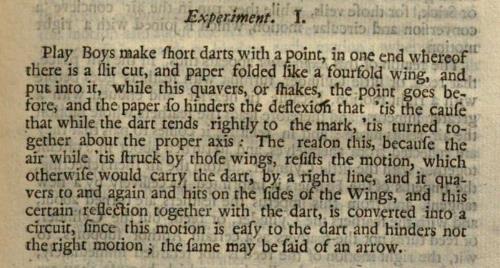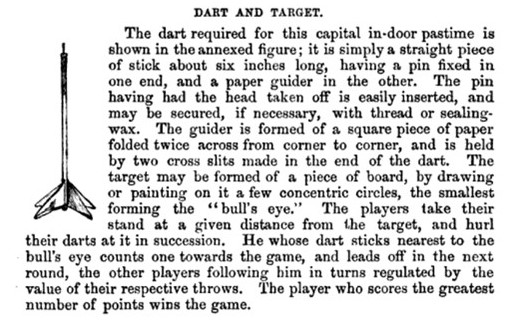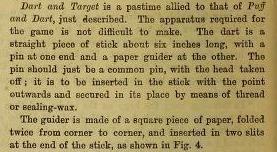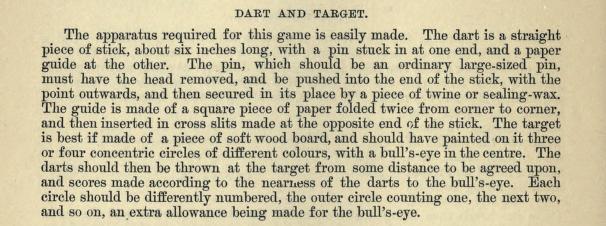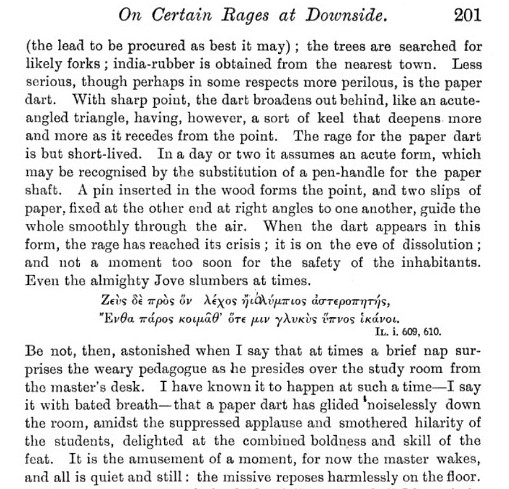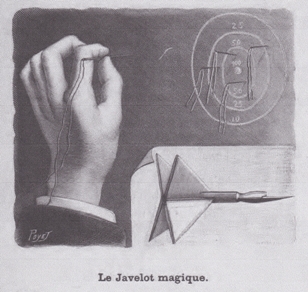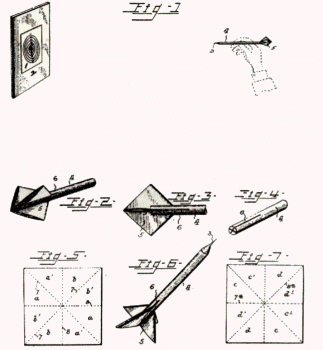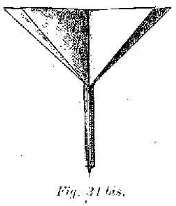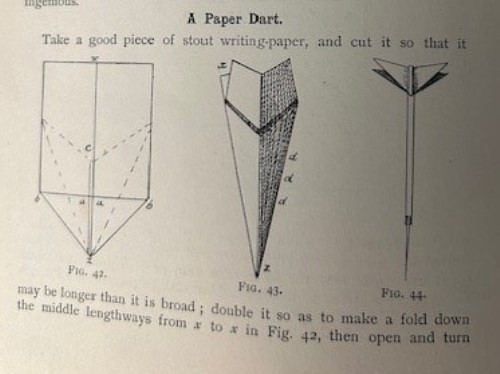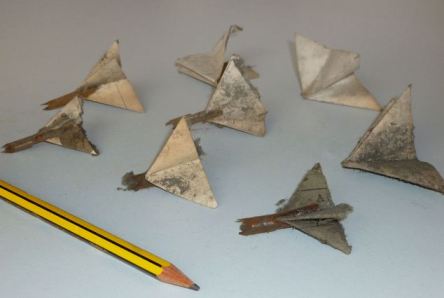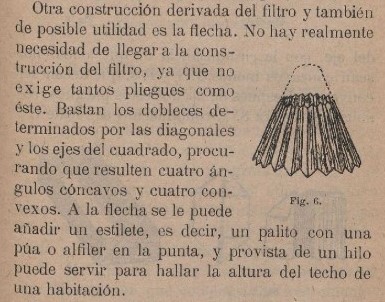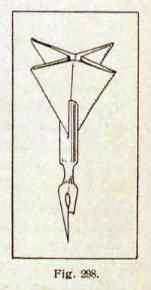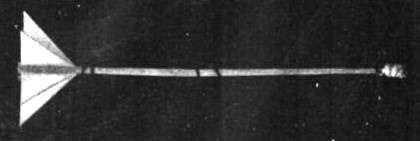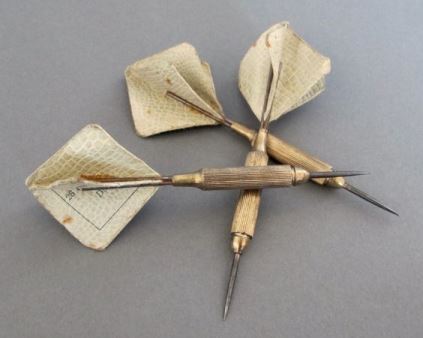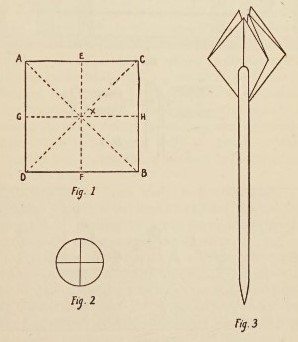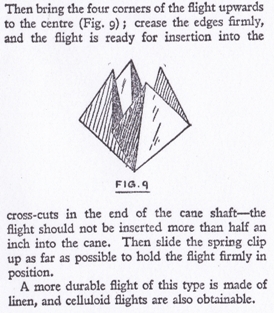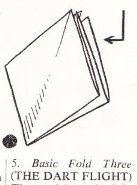| The Public Paperfolding History Project
Last updated 21/3/2024 x |
|||||||
| Paper Flights for Darts | |||||||
This page is being used to collect information about the history of Paper Flights for Darts, either attached to wooden dowels or metal pen nibs. Please contact me if you know any of this information is incorrect or if you have any other important information that should be added. Thank you. There is a separate page for the Paper Dart / Arrow design that we now think of as a paper plane and for small paper cones shot from a blowpipe. ********** 1657 'Les Jeux et Plaisirs de l'Enfance' which was published in 1657 contains 50 engravings of naked boys (or putti) engaged in playing various, often very robust, games, one of which shows them playing darts. The flights in this engraving look as though they could well be made of paper, possibly from a square folded into a waterbomb base. The engravings of 'Les Dards' was made by Claudine Bouzonnet-Stella (French, 1636–1697), after her Uncle, Jacques Stella (French, 1596–1657).
********** 1696 'Mechanick Powers: Or, The Mistery of Nature and Art Unvail'd' by Ven. Mandey and J Moxon, which was published in London in 1696, contains a passage referencing folded paper flights for darts.
********** 1859 'Games and Sports for Young Boys', which was published by Routledge, Warne and Routledge in London and New York in 1859, contains a description of the game of 'Dart and Target' which uses darts made of a wooden dowel with a pin at one end and a paper flight in the form of a waterbomb base at the other.
********** 1873 'The Popular Recreator', which was published by Cassell and Co in London in 1873, also contains a description of the game of 'Dart and Target'
********** 1881 As part of the game of 'Dart and Target',without illustration, in 'Cassell's Book of Indoor Amusements, Card Games and Fireside Fun', which was published by Cassell and Co in London in 1881
********** 1887 As 'The Self-Rectifying Dart' in 'How? Or Spare Hours Made Profitable for Boys and Girls' by Kennedy Holbrook, which was published by Worthington Co in New York in 1887.
********** 1889 Volume 8, Issue 3, of the 'Downside Review' for November 1889 contained an article entitled 'On Certain Rages at Downside' which mentions darts made from pen handles with paper flights. It is not clear if the 'two slips of paper, fixed at the other end at right angles to one another', which form the flights, are folded or not.
********** 1890 The first volume of 'La Science Amusante' by Tom Tit (real name Arthur Good), which was first published in Paris by Librairie Larouse in 1890, contained a drawing showing a pen nib combined with what I take to be a waterbomb base (though the French text does not specifically say this) to make a dart. This book, along with its two companion volumes, was a compendium of articles previously published in the French magazine 'L'Illustration'. I do not know the date that this article was originally published.
(As an aside, the method of turning a needle into a dart by attaching a piece of cotton was described De Viribus Quantitates, written by by Luca Pacioli and published in around 1502, chapter 134 of which is headed 'To toss a needle with a string and have it stay in the door or other wood'. ********** 1898 According to www.patrickchaplin.com/Paperflight.htm Nathan P. McKenney, of Dixon, in the County of Lee, Illinois, USA, filed a patent application on 11 March 1898, Letters Patent No. 613,386, which was approved on 1 November 1898. This site quotes the application to the effect that “My invention relates to toys and games, and particularly to a game apparatus of the ‘dart and target’ type, and has for its object to provide a dart, adapted to be projected manually, whereof the feather is of four-wing construction and is formed from a foldable blank of paper or other flexible material to adapt it to be replaced with facility”. An illustration from the application which shows that the flights were of two types, preliminary base and waterbomb base folds, is shown below.
The full patent can be viewed at https://patentimages.storage.googleapis.com/c9/dd/49/f5e2e044dbbd18/US613386.pdf ********** 1903 'La Ensenanza del Trabajo Manuel' by Pedro de Alcántara García and Teodosio Leal y Quiroga, which was published in Madrid in 1903, describes how to fold a waterbomb base and then how to attach it as a flight to a wooden dowel, which is either, in the case of young children, sharpened to a point, or in the case of older children, fitted with a pen nib to act as a point.
********** 1904 'The Book of Indoor Games' by J K Benson, which was published by C Arthur Pearson Limited in London in 1904, contains an illustration of a wooden dart with what are presumably paper flights, although the description seems to be mixed up with that of the Paper Dart per se.
********** c1912? In March 2012 the Daily Mail Online reported that a trove of paper planes (sic) had been discovered in the eaves of St Anne's Chapel, Barnstaple during renovations, presumably having been thrown up there around 100 years before by children when the building functioned as a school. As far as I know no attempt has been made to date these darts precisely. Source: https://www.dailymail.co.uk/news/article-2111963/Schoolboys-100-year-old-paper-planes-pre-date-manned-flight-eaves-chapel.html
********** 1914 'El Trabajo Manual en la Escuela' by Félix Martí Alpera, which was published by Libreria de los Sucesores de Hernando in Madrid in 1914, has a rather odd paddage about making paper flights. It says, roughly, 'Another construction derived from the filter and also of possible utility is the arrow. There is really no need to get to the construction of the filter as it doesn't need so many pleats. The folds of the diagonals and the axes of the square are enough, ensuring that four concave angles and four points (ie the waterbomb base or the preliminary fold). To the arrow you can add a stylus, that is a stick with a pin or prong at the end, and provided with a thread it can be used to find the height of a ceiling of a room.'
********** 1918 Darts made by attaching folded flights to pen nibs appear in 'Ciencia Recreativa' by Jose Estralella, which was published by Gustavo Gili in Barcelona in 1918.
********** 1923 Paper flights in the form of a waterbomb base appear in 'Falten und Formen mit Papier' by Richard Rothe which was published by Deutscher Verlag für Jugend und Volk in Vienna and Leipzig in 1923.
********** 1920s / 1930s This photo shows a set of three darts with brass barrels and paper flights which are probably From England and date to the 1920s or 1930s. The flights are probably cut from an old document as one has writing on it.
********** 1936 A design for a 'True-Aim Dart appears in 'More Things Any Boy Can Make' by Joseph Leeming, which was published by D Appleton-Century Company in New York and London in 1936.
********** 1939 There is a possible reference to darts made with paper flights in 'Coming Up For Air' by George Orwell, first published in 1939. 'And I got inky fingers and bit my nails and made darts out of penholders and played conkers ...' (p69 of the Penguin Modern Classics paperback edition). ********** 'How to Play Darts and New Games for the Dartboard' by John Young, published by Foulsham in London in 1939 contained the following information relating to folded paper dart flights:
Information from Patrick Chaplin. ********** 1956 In 'Paper Magic' by Robert Harbin, which was published by Oldbourne in London in 1956, his 'Basic Fold Three', which we now know as the Preliminary Fold, is called 'The Dart Flight'. No further information about the use of this fold as a Dart Flight is, however, given.
********** |
|||||||

